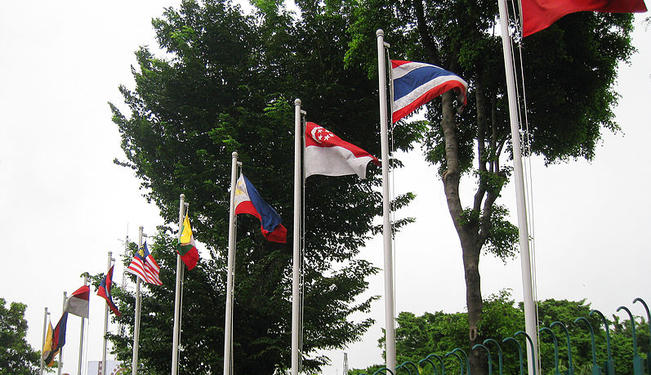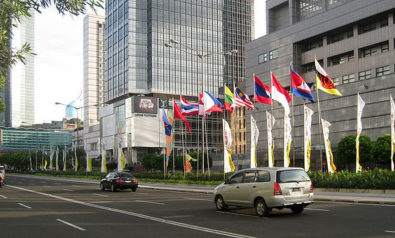The formation and working of ASEAN. Co-authored with Mithun Selvaratnam.
The Association of Southeast Asian Nations (ASEAN) is an inter-governmental political and economic organization currently representing ten member states in Southeast Asia. ASEAN works toward merging national and regional interests in an economically nubile sector of the world. Its ten member states combine to reach a population total of 600mn, while its combined nominal GDP approached $1.8tn as of 2010.
History
ASEAN was preceded by the short-lived ASA (Association of Southeast Asia), founded in 1961 by Thailand, Malaysia and the Philippines. These three countries would eventually cooperate with Indonesia and Singapore to draft and sign the Bangkok Resolution on August 8, 1967, which established ASEAN.
The organization expanded when Brunei joined in 1984, followed by Vietnam, Laos, Myanmar and Cambodia in the late 90s. As the organization’s size doubled, so did its emblem, which depicts ten yellow rice stalks on a backdrop of red and blue.
A majority of ASEAN’s members were decolonized only in the years following WWII. Indeed, the main impetus for the organization’s inception may have been the desire to fill in the power vacuum created by the recently withdrawn colonial powers. The organization operates primarily on an economic level, working to find compromises between the interests of each nation and the region as a whole. It also works within the political sphere, attempting to establish the region’s solidarity through its unified actions.
Structure
The highest body of ASEAN is the annual summit (ASEAN Summit). The chairmanship of the ASEAN Summit and Ministerial Conferences rotates annually between member states in alphabetical order. The Head Office of the ASEAN Secretariat is located in Jakarta, Indonesia; in addition, each country features its own local foreign minister. ASEAN is also divided into three central Community Councils: Political-Security, Economic, and Socio-Cultural, each of which presides over several Sectoral Ministerial Bodies.
ASEAN’s decision-making process features its own hierarchy, divided into Tracks. Track I encompasses all official decisions made by diplomatic representatives of the member states. Track II deals with hypothetical policies proposed mainly by think tanks and academic institutions, essentially serving as a forum for potential ideas. Track III is also a forum, one that consists of civil society groups and special-interest lobbies.
Though this structure implies the possibility of citizens‘ ideas trickling up to the inter-governmental level, the reality is that most of ASEAN’s decisions are made by senior officials, independently of the represented masses‘ knowledge.
Recent Developments
On December 15, 2008, the organization officially adopted the new ASEAN Charter, which establishes ASEAN as a legal entity and pushes the region closer to becoming a unified free trade sector. The Charter stresses peaceful settlement of disputes and respect for each state’s sovereignty and internal affairs. While this may signal that ASEAN is indeed moving towards reaching the status of the EU, the organization’s inability to impose sanctions and lack of judicial power puts its power of influence in question.
For more than 10 years, Fair Observer has been free, fair and independent. No billionaire owns us, no advertisers control us. We are a reader-supported nonprofit. Unlike many other publications, we keep our content free for readers regardless of where they live or whether they can afford to pay. We have no paywalls and no ads.
In the post-truth era of fake news, echo chambers and filter bubbles, we publish a plurality of perspectives from around the world. Anyone can publish with us, but everyone goes through a rigorous editorial process. So, you get fact-checked, well-reasoned content instead of noise.
We publish 2,500+ voices from 90+ countries. We also conduct education and training programs on subjects ranging from digital media and journalism to writing and critical thinking. This doesn’t come cheap. Servers, editors, trainers and web developers cost money.
Please consider supporting us on a regular basis as a recurring donor or a sustaining member.
Support Fair Observer
We rely on your support for our independence, diversity and quality.
Will you support FO’s journalism?
We rely on your support for our independence, diversity and quality.








